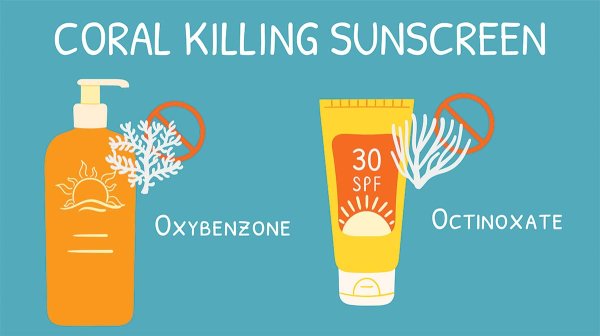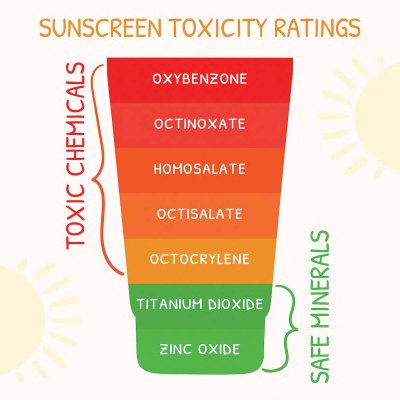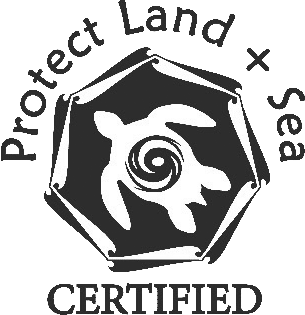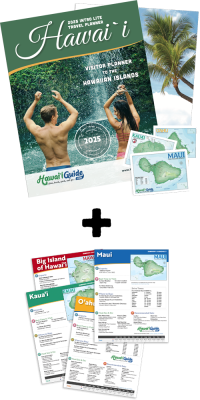Reef Safe Sunscreen: Understanding Hawaii's New Sunscreen Laws
Founder & certified Hawaii travel expert with 20+ years of experience in Hawaii tourism.
This article may include unbiased affiliate links at no extra cost to you. Mahalo for your support!
Aside from breathtaking hikes, swimming in the temperate Gatorade-blue ocean, and lounging on the world’s best beaches; one of the most common tales among those returning from a visit to Hawaii is that of the sunburn. Sunscreen really is an essential staple of the Hawaiian travel kit. That’s why, when Governor David Ige signed a bill back in 2018 that banned the sale of many of the most widely used sunscreen brands, it caught people’s attention.
Since then, most of us have perhaps forgotten about it - after all, let’s face it, a lot has happened in the 3 years since then. However, unbeknownst to many, the bill (SB2571) finally took effect on January 1, 2021. The law is not an outright ban on sunscreen; rather, it bans the sale of any sunscreen containing either oxybenzone or octinoxate “without a prescription issued by a licensed healthcare provider.”
We’ll cover what these chemicals are, and why they’ve become the targets of legal action, in a moment. What is extraordinary about the issuing of such a ban is that it made Hawaii the first state in the country to do so. However, although the ban is statewide, it doesn’t explicitly prohibit the use of sunscreen containing the two offending chemicals, nor does it even bother specifying what penalties, if any, should apply. Honolulu Civil Beat recently quoted both Senator Mike Gabbard, who introduced the bill in the first place and a lieutenant from the Kauai County police department, both of whom made it sound like the law is essentially not being enforced at all.

Off the Kona Coast in Kealakekua Bay, it’s a slightly different story. Exactly one year before the statewide ban took effect, The Hawaii State Department of Land and Natural Resources banned all use of such sunscreens by “commercial vessels” - i.e., the boats that take hundreds of tourists out for swimming and snorkeling every day. While this apparently crosses the boundary from banning sales to banning actual use entirely, it is however still not at all clear how it will be enforced. Fair Wind, one of the major cruise lines sailing regularly through the bay, says they are providing complimentary sunscreen to customers that meet the new legal requirements, but they’ve apparently been doing so since well before the law was enacted.
To what extent the law gets enforced or halts the sale or use of the proscribed sunscreens is, by all appearances, an as-yet unresolved question; but what are these chemicals in the first place, and why are they being banned?
Both oxybenzone and octinoxate are FDA-approved compounds that absorb and filter UV rays. In other words, they are in fact the active ingredients in an estimated 80 percent of sunscreens on the market. Unfortunately, there are studies, most notably one conducted in 2015 by Haereticus Environmental Laboratory, suggesting these ingredients are also like kryptonite to coral reefs when they wash off into the ocean, damaging the coral’s DNA, producing deformities and bleaching, even killing it altogether.
If banning sunscreen to save coral reefs raises your eyebrows, you’re not alone - the decision has been fairly controversial. The American Academy of Dermatology stated in 2018 that the ban could cause an increase in skin cancer rates in a part of the world where it is already unusually common.
FREE 2025 DOWNLOADS
Hawaii Intro Visitor Guide
+ Our Summary Guidesheets!
Includes the top must-see & do attractions, best times to visit, a monthly weather & visitor summary, and our tips on how to save when booking your car rental, tours, and activities. Plus, grab our free Hawaii Summary Guidesheets. Check out our 2025 Hawaii Visitor Guides.

Suncare in the US is a multi-billion-dollar industry. One way to interpret that is to recognize it means millions and millions of Americans are using a sunscreen every day to protect their health. Suddenly excluding the majority of that market in one of the states where it is used most certainly seems like it could be a risky move for public health.
Yet another way to interpret the size of the sun care industry is to see there are quite powerful brands with a heavy stake in the outcome of the new regulations. Johnson & Johnson, Proctor & Gamble, and L’Oreal alone own 30% of the sun care market and are something like heavyweight champions when it comes to sunscreens containing oxybenzone and octinoxate.
In an unsurprising 2018 public statement, the senior director of a national trade association which represents manufacturers for Johnson & Johnson and others condemned the new regulations, saying “two ingredients that are both safe and effective for use in sunscreen are being banned…” He went on to claim that other issues affecting coral reefs are more important, such as “global warming, overfishing, pollution, and runoff.”
The claim that oxybenzone and octinoxate are safe for humans is arguably a dubious one. 29 studies have been done on the causal relationship between the two chemicals and human health, and their findings have been somewhat mixed. In particular, oxybenzone has been associated with effects on hormones and kidney function; but the current NCBI conclusion is that further research is needed and that no conclusive evidence currently exists for adverse impacts on human health by either chemical.
Even if oxybenzone and octinoxate do turn out to be safe for humans, the truth is that it may be something of a false choice. Conspicuously absent from these corporate-sponsored discussions is the fact that viable alternatives to both chemicals exist and can be found in numerous commercially available “reef-safe” sunscreens.

Zinc oxide and titanium dioxide, when combined, are effective at protecting the skin from UV rays and are less harmful to coral reefs. The Haereticus Environmental Laboratory maintains the HEL List, which identifies sunscreens that are not safe for reefs. Simultaneously, they also provide the Protect Land + Sea Certification which you can often find on sunscreen containers as a seal of reef-safety approval.
Hawaii’s new sunscreen regulations are an understandably contentious issue, but parsing through it all, it seems clear that a “win-win” is available. Numerous sunscreens exist which can both protect us from harmful UV rays and protect coral reefs from damage at the same time. What remains to be seen is how effective the new regulations are at shifting the massive sun care market towards favoring these universally healthier alternatives.
Suggested Reef Safe Products
The below are affiliate links that we get a commission from if you decide to purchase.
Related Topics
Affiliate Disclosure: We may earn commissions from some travel partners (like Amazon or Expedia) which helps us maintain this site. These links are at no extra cost to you and don't impact our honest & unbiased recommendations. Remove all the ads →





